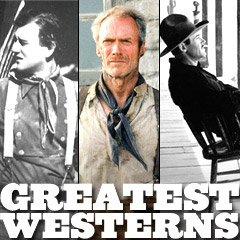
|
Greatest Westerns Silents-1930s |
| Film Title/Year/Director/Length/Studio, Setting (or Time Period) and Brief Description | |
The Great Train Robbery (1903)
One of the milestones in film history was this first narrative film - a primitive one-reeler action picture, about 10 minutes long with 14 scenes, filmed in November 1903 on the East Coast. It was the most popular and commercially-successful film of the pre-nickelodeon era, and established the notion that film could be a profitable and viable medium. The story, about bandits robbing a moving train, used a number of innovative techniques, many of them for the first time, including parallel editing, minor camera movement, location shooting and less stage-bound camera placement. |
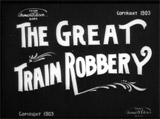
|
The Covered Wagon (1923)
Considered the first great western epic - an authentic-looking film recreating the 1848 tale of a pair of wagon trains moving towards Oregon. The tagline bragged: "Indian Attacks, Prairie Fires, Fording of Swollen Streams, a Great Buffalo Hunt, Dramatic Situations Galore --- All Go to Make Up 'The Covered Wagon'." The group of wagons was led by Jesse Wingate (Charles Ogle) and Will Banion (J. Warren Kerrigan). Also included was a slight romantic love-triangle storyline regarding Jesse's daughter Molly Wingate (Lois Wilson), engaged to fiance Sam Woodhull (Alan Hale) but showing growing interest in Banion. With impressive scenes copying the many elements of the series Western (earlier seen in the silent films of Tom Mix and Broncho Billy) - including Indian attacks and shoot outs, wagons crossing rivers and braving snow storms, and a buffalo hunt. |
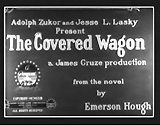
|
The Iron Horse (1924)
This was Fox Film's silent western epic-scale response to The Covered Wagon (1923). Noted as the film to establish John Ford's reputation as one of Hollywood's most accomplished directors. The slowly-paced film was a combination of a fictitious narrative, interwoven with historical background. It told the story of an Illinois man, hero Dave Brandon (George O'Brien), searching for the shortest route over a mountain range to unite the Union Pacific (starting from Omaha, Nebraska) and Central Pacific (starting from Sacramento, California) - two railroads at Promontory Point, Utah in 1869. Noted for realistic scenes of a cattle drive, an Indian attack, a saloon brawl, and the Pony Express, and appearances of historical figures including Wild Bill Hickok (Jack Padjan), Buffalo Bill (George Waggner), and Abraham Lincoln (Charles Edward Bull). |
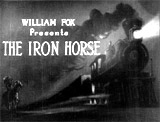
|
Tumbleweeds (1925)
A William S. Hart classic from the popular silent western hero of the time - and his last movie (of almost 70 films) over a ten-year period. Hart played rancher Don Carver who was displaced by the onslaught of homesteading farmers. The most spectacular scene was the Oklahoma land rush of homesteading farmers in many types of conveyances (covered wagons, stagecoaches, surreys, even a big-wheeled bicycle). |
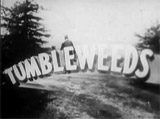
|
The Big Trail (1930)
This was the first epic western talkie - a big-budget production (and box-office failure) filmed in both 35mm and in the 70mm "Fox Grandeur" wide-screen process, and shot on-location to enhance its authenticity. The plot presented the travails of a wagon-train along the way - Indian attacks, harsh weather conditions (snow storms), and other challenges. With western iconic star John Wayne (previously named Marion Morrison) in his first leading role as Breck Coleman - although the film put John Wayne back into minor B-western roles from Poverty Row studios until 1939. Coleman joined prairie schooners crossing the vast West - his motivations to scout for the wagon trail were to seek revenge against the killers of his recently-murdered trapper friends - Red (Tyrone Power, Sr.) and Lopez (Charles Stevens), and to romance Southern belle Ruth Cameron (Marguerite Churchill). |
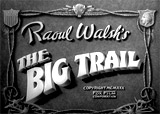
|
Cimarron (1931)
A dated, un-PC, soap-operish film based upon Edna Ferber's original 1930 novel, about a husband and wife - adventurous, wanderlusting newspaper editor Yancey (an over-the-top Richard Dix) and reluctant Eastern-bred Sabra Cravat (Irene Dunne) with their toddler named Cimarron, struggling for survival in the early days of the Oklahoma Territory, and later scenes of the evolution of the westward-expanding frontier (and empire-building in the 1920s). MGM remade the film in Technicolor in 1960, with Glenn Ford and Maria Schell as the Cravats. |
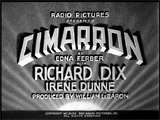
|
The Plainsman (1936)
Flamboyant director DeMille created this fictionalized (truth-stretching), romanticized and entertaining adventurous film which, in a hodge-podge, brought together many famous names from the West, including Wild Bill Hickok (Gary Cooper), stagecoach-driver Calamity Jane (Jean Arthur), army scout William "Buffalo Bill" Cody (James Ellison), and General George Custer (John Miljan). The western villain was John Lattimer (Charles Bickford), in Missouri as a gun-running trader to the Cheyennes, and fueling the Indian uprisings on the Plains. The Indian-besieged Fort Piney needed to be resupplied with ammunition by orders of General Custer, while Hickok tracked after Chief Yellow Hand (Paul Harvey). After a raiding party on the Cody home, Calamity Jane and Hickok were both captured, and as Hickok was about to be tortured over an open fire pit, Jane was forced to reveal the whereabouts of Cody leading the relief column (with ammunition supplies) to Fort Piney. Cheyenne Indians (with Lattimer's contraband repeating rifles) ambushed the supply train, its few soldiers, and Cody (aided by Hickok who was freed and joined them) - all of whom were saved with a repulsing counter-attack by General Custer (who had been alerted by Jane). However, Custer felt Hickok was involved in the murder of some of Lattimer's men and ordered Cody to capture him. Meanwhile, Custer's own 7th Cavalry was defeated by Sitting Bull and the Sioux Indians at the Battle of the Little Big Horn in 1876. Both the Sioux and Cheyenne Indians were on the warpath in the Black Hills against white encroachment - using Lattimer's seven-shot repeating deadly weapons ("thundersticks"). In Deadwood City, Dakota Territory, Hickok self-defensively killed Lattimer. Later during a saloon poker game in the nearby saloon where he had taken some of Lattimer's gang members (awaiting the arrival of the military to take them away), Lattimer's vengeful cohort Jack McCall (Porter Hall) shot Hickok in the back, as he was holding the "dead man's hand" - black aces and three eights. In the finale, Jane cradled Hickok's dead body. |
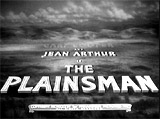
|
Way Out West (1937)
One of the best Laurel and Hardy comedy films, and their only western spoof. Again, they reprised their most familiar roles: Stanley, the thin, meek simpleton, and Ollie, the fat, pompous one. The film's plot was simple: Stan and Ollie arrived at the western town of Brushwood Gulch on a secret mission to deliver a valuable gold mine deed to Mary Roberts (Rosina Lawrence). She was the orphaned daughter of their recently-deceased prospector friend, and a demure kitchen maid in Mickey Finn's (James Finlayson) Palace saloon in town. Outside, the pair performed a cute and charming soft-shoe dance routine to the 1905 hit tune: "At the Ball, That's All." When they stupidly admitted their objective to Finn, the unscrupulous owner had his wife/saloon singer Lola Marcel (Sharon Lynne) impersonate Mary so he could acquire the deed. Finn's plan worked, as the bumbling duo turned over the deed (and a locket belonging to Mary's father) to Lola, and they tricked Mary into signing away her rights to the deed. As it turned out, the boys happened to meet Mary and realized their error. When Stan momentarily retrieved the deed, he was locked in Lola's bedroom, where he was cornered, wrestled and tickled to death - an excruciatingly funny sequence. After a long extended chase for the deed, Finn locked it in his safe. Their plan that evening (after Stan was forced to literally eat his hat) was to break into Finn's safe on the second floor of the saloon and steal back the deed, using their mule Dinah as a counterweight. After succeeding in retrieving the deed, the duo and Mary left town together. |
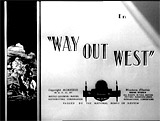
|
Destry Rides Again (1939)
A popular and marvelous Western comedy spoof/farce from Universal Pictures. Director George Marshall parodied and satirized the classic Western with its stereotypical elements - a lawless Western town with a saloon and a sheriff, peppered with three saloon/musical numbers! Notable as James Stewart's (and Marlene Dietrich's) first westerns early in their careers, with Dietrich reprising her sexy role from The Blue Angel (1930), especially with the song: "See What the Boys in the Back Room Will Have." In the town of Bottleneck, villainous gambler Kent (Brian Donlevy) and the corrupt mayor appointed the town's drunk, Washington Dimsdale (Charles Winninger) as sheriff. He then chose a new type of gunless, pacifistic, milk-drinking deputy - Thomas Jefferson Destry (Stewart). Noted for the scene of a frenzied catfight between saloon singer Frenchy (Dietrich) and Mrs. Callahan (Una Merkel). |
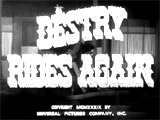
|
Dodge City (1939)
A landmark, action-packed Technicolored western with a Max Steiner score produced in one of filmdom's most famous years, and the first western for swashbuckling star Errol Flynn (as cattleman Wade Hatton) in the western town run by corrupt cattle dealer Jeff Surrett (Bruce Cabot). Flynn was making his eighth of ten films opposite star Olivia de Havilland (as love-interest Abbie Irving). With all the stock components and formulaic sequences of typical westerns - a frontier town, a massive bar-room brawl, cattle rustlers, a wagon train, a cattle stampede, the crime-fighting sheriff vs. outlaws, flirtatious dance-hall girl Ruby Gilman (Ann Sheridan) in the Gay Lady gambling saloon, a cold-blooded professional killer Yancey (Victor Jory), a shootout on a hijacked train on fire, etc. |
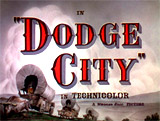
|
Jesse James (1939)
Advertised in its tagline as: "The Epic Story of the Most Colorful Outlaw Who Ever Lived," and although the Technicolored western claimed to be an accurate portrayal of the notorious outlaw brothers (the James gang), it failed to capture the ruthless nature of the glamorized heroes - viewed as Robin Hoods. Due to its box-office success, Fritz Lang directed the sequel, The Return of Jesse James (1940). Tyrone Power starred as the likeable Jesse James, while Henry Fonda co-starred as his tobacco-chewing brother Frank. The plot followed the James boys from their early days as a farm family in Missouri, struggling against big business (specifically the St. Louis Midland Railroad) - with crooked railroad agents and hired guns. Their life as fugitive criminals after becoming train and bank robbers began after Jesse self-defensively shot one of the aggressive agents named Barshee (Brian Donlevy). In a subplot development, Jesse's girlfriend Zerelda (or "Zee") (Nancy Kelly) - who wished for Jesse to settle down - began a side-romance with Liberty's marshal Will Wright (Randolph Scott) due to Jesse's frequent absences. She was the niece of town newspaper editor Major Rufus Cobb (Henry Hull). One celebrated action scene was a reenactment of their unsuccessful and risky Northfield Minnesota Bank robbery. In the conclusion set in the year 1882, an unarmed, badly-wounded 34 year-old Jesse (who had just decided to reunite with his family and make a new life in California) was shot in the back by cowardly trusted friend Bob Ford (John Carradine). [Note: A horse killed in a cliff jump during filming resulted in the American Humane Association monitoring subsequent movies to protect animals.] |
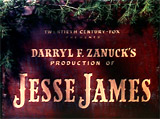
|
Stagecoach
(1939)
This was the first film collaboration between film auteur-director John Ford and John Wayne (in the film that made him a major star in his role as the Ringo Kid). Filmed in the Southwest's gorgeous Monument Valley. This was Ford's first sound Western - marking a return to his most-acclaimed film genre. By 1939, the Western genre had fallen out of favor, but Stagecoach (1939) helped reinvent the genre, providing for its rebirth. With seven Academy Award nominations and two wins: Best Supporting Actor (Thomas Mitchell) and Best Score (for its compilation of 17 American folk tunes of the 1880s). This revolutionary, influential film was considered a landmark quintessential film that elevated westerns from cheaply-made, low-grade, Saturday matinee "B" films to a serious adult genre - one with greater sophistication, richer Western archetypes and themes, in-depth and complex characterizations, and greater profitability and popularity as well. |

|
Union Pacific (1939)
An action-oriented, melodramatic, sweeping epic western (that reworked actual history) from masterful director DeMille, about the construction of the trans-continental railroad, stretching from Omaha, Nebraska to California, and ultimately uniting the Central Pacific and Union Pacific Railroads (similar to John Ford's earlier The Iron Horse (1924)) in Utah. It was the director's last black and white film. It was the top-grossing Western of the year, but lost its sole Oscar nomination (for Best Special Effects). An unscrupulous, opportunistic Eastern financier, represented by wealthy bank president and stock manipulator Asa M. Barrows (Henry Kolker) of the Central Pacific (building eastward from California), hired suave gambler-hall proprietor Sid Campeau (Brian Donlevy) and his reckless partner Dick Allen (Robert Preston) to sabotage and cause the failure of the competing Union Pacific (building westward). There was a big-stakes race of both railroads to reach Ogden, Utah for the connection of the two lines. Their tactics to delay the work included enticing the Union RR workers with alcohol, gambling, women, and instigating rebellion over late wages (with a payroll robbery). On the opposing side, the Union Pacific hired Captain Jeff Butler (Joel McCrea) to be a tough-guy troubleshooting lawman to prevent any difficulties, including the keeping of peace with the Indians, putting down worker strikes, and counteracting the efforts of Campeau and Allen (who was Jeff's ex-Civil War buddy). In the competitive mix was a descendant of Irish immigrants, Irish-brogued engineer's tomboyish daughter Mollie Monahan (Barbara Stanwyck). She was caught in the squabbles and in a love triangle between Jeff and Allen (who married Mollie!). In the exciting finale, Mollie was killed in a collapsing train steam engine during a derailment wreck, as the Union Pacific raced to Ogden and beat the conniving forces of the Central Pacific. As the golden spike was driven into the tracks, Campeau killed Allen. |
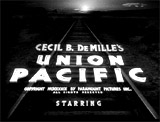
|
(chronological by film title) Introduction | Silents-1930s | 1940s | 1950-1955 | 1956-1959 | 1960-1965 1966-1969 | 1970s | 1980s-1990s | 2000s | 2010s |